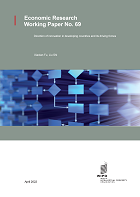Direction of innovation in developing countries and its driving forces
Economic Research Working Paper No. 69
作者: Xiaolan Fu
作者: Liu Shi
出版年份: 2022
DOI: English

Innovation is a major driving force of long-term economic growth and sustainable development. Direction of innovation matters because technical change is not neutral and hence bears significant social, economic and environmental development implications. This paper contributes to the literature through a systematic examination of the direction of innovation in developing and emerging economies and its driving forces. It shows that innovation in the global South exhibits a vibrant and diverse landscape when we do not confine ourselves with traditional research and innovation indicators. While emerging economies are accelerating their pace in inventive activities in fields such as ICTs, biotech and engineering, low-income countries (LICs) are also found to be active in learning-based, incremental “under-the-radar innovations” (URIs). These URIs that are introduced through international technology transfer and indigenous innovative efforts. Indigenous sources of URIs play a primary role in LICs, contributed by localised learning-by-doing, close interaction with customers and embeddedness in regional production networks and clusters. However, insufficient role of the state, a low science and technology intensity and a lack of university-industry linkage limit the potential of URIs. International technology transfer is another important driver of technical change in developing countries. However, its strengthen varies across countries due to differences in host country policy, absorptive capacity, and the type of foreign economic engagement that they have as well as the inappropriateness of transferred foreign technologies mostly from Global North. Given the status of direction of innovation and its driving forces in developing countries, this report argues that the unfolding 4th industrial revolution poses both challenges and opportunities to LICs. Policy implications are discussed.
